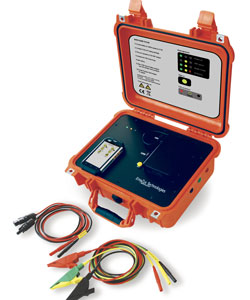A new system designed to make solar cell installations even more reliable is to be tested in partnership with DTU Fotonik and DTU Nanotech.
Opportunities to generate green energy through the use of solar cells continue to gain ground. However, even though the work to develop new and improved products is progressing rapidly, there is still room for major improvements in the field of maintenance.
It is against this background that researchers from DTU Fotonik and DTU Nanotech have teamed up with Aalborg University and two private companies and are working flat out to develop an advanced method for fast and accurate troubleshooting of solar cell installations.
The problem with solar cells is that it can be difficult to find out precisely what is wrong, and where the fault lies. This often translates into major losses of important green energy—and, ultimately, money—when sensitive solar cells shut down.
The start-up EmaZys has developed a system that sends a variety of signals through solar cell installations and then, on the basis of the time it takes for the different signals to be reflected back, calculates both the nature and the location of the problem. Peter Behrensdorff Poulsen, Project Manager at DUT Fotonik, is currently setting up two test platforms at DTU Risø Campus. He predicts that the system will save appreciable resources in future.
“Unfortunately, it seems that we in Denmark will never be able to keep pace with the actual production of solar cells, but there is an associated service market that is currently under-populated—so there are plenty of opportunities here for this type of technology. The easer it becomes to identify errors so that you don’t lose out on production, the more useful your solar cells become—that’s basic logic,” he explains.
Links with the idea environment
That is why DTU has decided to support the project with funds from the Energy Technology Development and Demonstration Programme (EUDP) under the Danish Energy Agency. The team at EmaZys, the company that developed the diagnosis system, is delighted with the news.
 “We’d love to bring in new eyes to have a look at our project. At the same time, it’s essential to maintain close links with the idea environment—not only to have access to research results, but also to apply a holistic approach to what we’re doing. It adds credibility to work with partners such as DTU and Aalborg University,” says Anders Rand Andersen, PhD in physics and founder of EmaZys.
“We’d love to bring in new eyes to have a look at our project. At the same time, it’s essential to maintain close links with the idea environment—not only to have access to research results, but also to apply a holistic approach to what we’re doing. It adds credibility to work with partners such as DTU and Aalborg University,” says Anders Rand Andersen, PhD in physics and founder of EmaZys.
Just like Peter Behrensdorff Poulsen, Anders has identified an opportunity for Danish companies to ride the new area of the green energy wave:
“The fact of the matter is that a lot of solar cell installations have been sold as ‘maintenance-free’, but now we’re waking up to reality and realizing that problems are beginning to arise in the area of maintenance. Simply put, an operation and maintenance industry is gradually developing—and it is this market we need to participate in,” he explains, referring to the fact that service and maintenance in the wind turbine industry currently accounts for an appreciable share of turnover in the sector.
The little orange suitcase
The official name of the measuring unit developed by EmaZys is Z100, but it is commonly referred to as ‘the little orange suitcase’. The unit is simple to transport, but a trained technician is required to run the tests. However, the future may well see additional development of the equipment to the benefit of the environment and of Danish companies keen to establish a foothold on the market for green energy.
“In the long term, it is eminently possible to envisage the unit becoming a component actually built into solar cell set-ups to identify faults at an early stage so they can be fixed before they cause serious problems. This, too, would open up completely new opportunities,” concludes Peter Behrensdorff Poulsen.